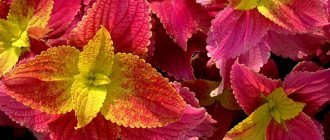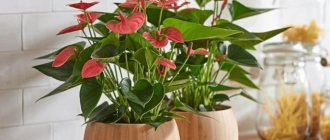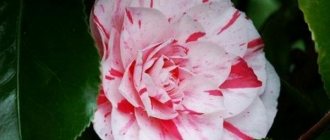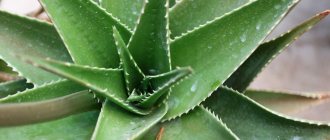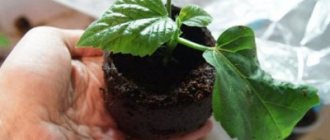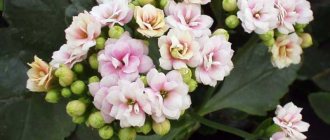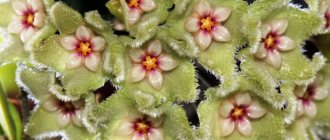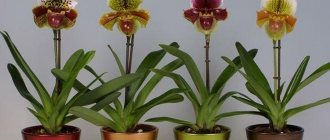These colorful plants belong to the Lamiaceae family - they are relatives of sage and mint. Previously, the genus Coleus consisted of about 150 species, but in the modern classification only two remain: Coleus decurrens and Coleus forskohlii. And all the rest, including Coleus Bloome (this is what is grown at home) were classified as another genus - the spur flower. And our homemade coleus is now officially called Plectranthus scutellarioides. But what’s most interesting is that Carl Linnaeus originally named this Coleus basilica (Ocimum scutellarioides). This is the plant’s confusing history. But we, paying tribute to tradition, will call it coleus.
Our homemade coleus comes from the tropical regions of Asia and Africa. In warm regions it is grown in open ground, but in the harsh realities of Russia it has taken root as a houseplant. By the way, coleus began to be grown as an ornamental plant not so long ago: the first mention of it in this status was found only in 1918 - it was included in the list of plants of the Antilles (1). A variety of shapes and colors appeared in 1918 in Bermuda.
Coleus is a herbaceous plant, but in the lower part its shoots become woody. In nature, it can reach a height of 1.5 m. It blooms with inconspicuous panicles of different shades of blue.
Coleus varieties
There are a great many varieties of coleus. They differ in height, shape and color of leaves:
- Freckles - orange leaves with large yellow spots, height 25 - 35 cm;
- Wizard Velvet Red - deep burgundy leaves with a light green border along the edges, height 30 - 35 cm;
- Wizard Pastel - leaves with patterns of cream, pink and green shades, height 30 - 35 cm;
- Dragon Black - fringed leaves of dark red color with a wide purple border, height 30 - 35 cm;
- Collins Gold - with corrugated yellow leaves with a wide green stripe in the center and rare burgundy spots, height 25 - 35 cm;
Wizard Pastel. Photo: pixabay.com
Wizard Velvet Ed. Photo: pixabay.com
Saturn. Photo: pixabay.com
Weasley Tapestry. Photo: pixabay.com
- Saturn - leaves of red-chestnut color with a wide green spot in the middle and a thin green edging along the edge, height 30 - 40 cm;
- Twist and Twirl - variegated leaves, with a succession of yellow, green, red and brown shades, height 30 - 40 cm;
- Wisley Tapestry - ampelous variety, red leaves, with a wide yellow-green border, height 30 - 35 cm;
- Hedwig - yellow-green leaves with a large burgundy spot at the base and numerous specks and strokes of the same shade, height 30 - 35 cm.
Use in landscape design
Coleus flower, planting and care at home, photo
Currently, the use of coleus in flower arrangements by landscape designers is not uncommon. A beautiful combination can be obtained by combining plants with monochromatic colors. The most harmonious are coleus compositions with the participation of sage, cineraria, lily, daylily, and gypsophila. A classic option is the combination of purple nettle with yellow marigolds, red salvia, and cineraria with a silver tint.
Red nettle with silver alyssum looks ideal. Several types of coleus can be used to create an attractive carpet bed or arabesque. A “Persian carpet”, which contains different varieties of subshrubs, can beautifully decorate a lawn. To decorate a small patio, you can use a container containing a composition of colorful coleus, cannas with red leaves, in addition to green or yellow flowers.
Dwarf coleus, when combined with trimmed boxwood borders, makes an excellent decoration for rose gardens. Red and burgundy roses can be successfully combined with pale green or golden coleus. Often, hanging nettle is used to decorate loggias. The balcony, which is decorated with such original bright vegetation, looks unique and attractive.
The most effective combination of kuleus with other ornamental plants
Making a flower bed is not difficult. The perimeter of the form is lined with trimmed boxwood or evergreen Iberis. The main color accents are formed using different rose bushes. The space between them is filled with dwarf coleus varieties “Ear of Nana” or “Fiberb”.
They grow no more than 30 cm, have beautiful brightly colored leaves with decorative carved edges. When using coleus, the gardener’s main task is to create compositions so that the bright color of their leaves does not dull the color of companion flowers used for landscaping a flower bed, lawn or rosalia.
An example of a successful combination will help you create other compositions. Coleus with light green leaves with a golden edge go well with burgundy roses on a tall, long stem. This is what they look like in the photo.
The variegated leaves of coleus go well with plants whose leaves have a single color. Beautiful combinations in landscape design are created by the described flowers paired with sage, gray fescue, and cineraria. They can become an excellent background for the bright colors of coleus.
There are ampelous forms of beautiful nettles. They are used to decorate hanging baskets - the main attribute of landscaping balconies and loggias. They can be combined with surfinia and white-edged budra.
Note! In order to independently compose successful compositions, experienced gardeners recommend growing seedlings of different varieties in small pots
Then you can easily take them outside, place them in flower beds, along garden paths, on lawns, and take a closer look at the combinations you like. If the pattern forms the desired picture, you can safely plant the coleus in the ground.
There are never too many culeus. With the help of them, at any time, experienced designers always cover up particularly unsightly, dull places in flower beds, flower beds or lawns. Here is another example of the use of the described plant. Let's say there is a plot of land planted with seasonal flowers. When their flowering ends, the flowerbed or rosalia turns into an unsightly object.
Multi-colored coleus, those that flaunt in pots on the windowsills of the house, help save the situation. The practicality of the plant helps to use them for decorating regular flower beds and natural style flower beds.
Coleus care at home
Coleus is an unpretentious plant, but there are several nuances that must be taken into account when growing.
Priming
The ideal soil mixture for coleus is a mixture of leaf soil, turf soil, peat and sand in a ratio of 1:1:1:1 (2). But you don’t have to worry about it; in general, coleus plants are undemanding when it comes to soil; you can grow them in purchased universal soil or special soil for decorative foliage plants.
Temperature
During the period of active growth (from March to October), coleus requires a temperature within 25 ° C. And in winter it needs cooler content - 16 - 20 ° C. At higher temperatures, the plants stretch out, however, this is not a problem - they can be pruned in the spring.
Lighting
These plants are very photophilous and can grow even in direct sunlight. In the shade they become very elongated, their color noticeably fades. The ideal place for coleus is east or south windows.
Humidity
Coleus loves abundant watering - if the soil dries out, it instantly withers. He also likes high air humidity, so it is useful to spray the plants from time to time, especially on hot days in summer.
Fertilizers
When planting in a pot, you do not need to add any fertilizers - for the first time, the soil for coleus contains all the necessary nutrients.
Feeding
The first feeding of coleus can be given 2 weeks after planting. In the future, feeding should be as follows:
- from the end of March to the end of February, feed once a week;
- from November to March – once every 2 weeks.
It is best to use liquid complex fertilizers - any will do.
Trimming
Coleus tend to stretch out, exposing the lower parts of the shoots, so from time to time you need to pinch the tops of the coleus - this way it will bush better.
If the coleus has become very elongated in winter, in March it can be cut into a stump, leaving 5 - 8 buds.
Requirements for growth
To grow beautiful coleus, care at home should correspond to what the flowers receive in nature. To assess your own capabilities, first, some useful tips on arranging a space for a flower:
The bright color will please the eye if coleus is placed among ordinary green plants - not variegated, not multi-colored. The same rule applies in the flowerbed.
To grow a flower in open ground, it is better to select varieties with small leaves. They bush faster, grow and look very decorative.
Coleus is a houseplant that does not tolerate dry air and soil. If you forget to water it, the shoots will lose turgor. In this case, you need to urgently pour water and spray it generously. In winter, this happens more often if the plant is located near radiators.
The liquid for spraying is distilled, since tap water leaves stains and the flower loses its decorative effect.
The remaining features of planting, growing and caring for coleus should be described in more detail for those who have never encountered this species and do not want to make a mistake.
Light
African tropical plants are lovers of bright light. In summer, during the growing season, they need full daylight hours: 14 - 16 hours. In winter, preferably 12.
To constantly be under the rays, the coleus must stand close to the window. The best place for it is a glassed-in balcony. Since the leaves of decorative nettle are thin and delicate, the flower needs to be shaded with blinds or tulle.
Fluorescent or phytolamps will be needed in winter. Fans of indoor plantings are recommended to buy such a device, as it will be useful not only for coleus, but also for other species.
Temperature
Plants from hot countries like dormant periods with a slight drop in temperature. The same goes for coleus. In summer, heat up to 30 degrees is permissible, higher is not advisable, since the metabolism in the tissues is disrupted and the flower may die. To enhance evaporation, it is recommended to spray the crop in the morning and evening when the temperature drops. If there is extreme heat, the flower sheds its leaves and stops growing.
The dormant period of coleus begins in late autumn and lasts approximately 3 months. At this moment, it is advisable to reduce the temperature to 16 - 18 degrees and maintain it at this level. An unpleasant feature of the flower is that it does not like temperature changes of more than 7 degrees in one direction or the other. In this case, the coleus may also go into hibernation.
Be careful in the spring: if you put pots of coleus outside, the temperature drop at night can reach 12 degrees. The plant is guaranteed to die in such a situation.
It must be protected from wind and rain. The best option is a closed veranda.
Watering, air humidity
Hybrid coleus really needs regular watering. Its leaves are thin and soft, so they are the first to suffer from drought. It is necessary to spray the bush even in winter, when it is at rest.
The liquid should be soft - rain or melt. It is advisable not to use chlorinated water from the tap. If the flower overwinters indoors on a windowsill, under which there is a radiator turned on, then you need to wet the towel daily and cover the radiator.
In the case of aluminum or bimetallic models, place evaporation containers on top. This will increase the air humidity in the room, which will be beneficial for both people and flowers. A humidity level of at least 70% is the flower’s requirement in summer and winter.
Coleus, when planted and cared for in open ground, are more resistant to weather conditions, but the flower bed must be constantly moist to a depth of 1 cm. In summer, the plants are watered 1 - 2 times. More often - in the evening after sunset.
Type of soil
Coleus prefers soil rich in organic matter and nitrogen. Its acidity varies between neutral and slightly acidic. The more nitrogen components in the soil, the brighter the flowerbed will look.
You can buy soil mixture at the store or prepare it at home yourself. Includes:
turf and leaf humus, 4 parts each;
1 part each of sand and perlite for looseness;
1 part peat;
2 parts of rotted mullein, horse humus will do.
There is no need to calcinate the soil before planting plants in pots, since this crop is resistant to fungal spores.
Be sure to use drainage, pouring a third of it into the pot. Expanded clay or pebbles remove excess liquid from the roots, they breathe well and absorb nutrients.
Each subsequent pot should be larger by about 2 - 3 cm.
Propagation of coleus at home
To propagate coleus, 2 methods are used.
Cuttings
This is the simplest option; the cuttings of these plants quickly and easily produce roots - in an ordinary glass of water they appear within 8 - 12 days (2). Rooted cuttings can be immediately planted in pots.
Seeds
Coleus seeds are sown in plastic containers from February to March. They are evenly distributed over the surface of the moist soil and lightly sprinkled with sand. At a temperature of 20 °C, seedlings appear after 2 weeks. During growth, they need to be picked three times (2):
- in the cotyledon stage;
- when the second pair of true leaves appears;
- a month after germination - at this time they can be planted in permanent pots.
Distribution and ecology
Widely distributed in the temperate zone of the Northern Hemisphere: Asia Minor, Western and Central Asia, Transcaucasia, Mongolia, China, Japan, Korea, northern Hindustan, almost all of Europe.
In Russia it is found very often in the European part, the North Caucasus, Siberia and the Far East.
Prefers shaded places with sufficient moisture along the banks of ravines, where it forms dense, low thickets.
It grows in gardens, orchards, on streets, near fences and outbuildings, and less often in bushes and forests. Weedy. It is a food plant for the leaf beetle.
Coleus diseases
Coleus practically does not get sick, but it may have problems associated with improper care.
Coleus is withering. There are 3 reasons for this phenomenon:
- insufficient watering - coleus plants are sensitive to drought;
- drafts - these plants cannot tolerate sudden changes in temperature and may even die;
- cold window sill - if the soil is cold, the roots are not able to extract water from it and even with watering the plants wither.
Leaves are falling. The reason is lack or excess of watering.
The leaves are turning pale. This happens if the plant does not have enough light.
Botanical features and homeland of coleus
Overview of aster species and varieties
Description of Coleus. The plant belongs to the Lamiaceae family. The perennial flower was brought to Europe from the hot African tropics. In addition, it can be found in Australia and India. Coleus is very similar to nettles. You can verify the similarity of a flower with grass by touching the velvety leaves, which have a similar shape. The average height of the stem is 50 cm. Often the leaves are heart-shaped with elaborate patterns of red or burgundy. There are small teeth on the edges of the leaf.
Coleus flowers are not particularly interesting, although they look quite nice. They are colored blue or purple and resemble spikelets. Amateur flower growers call them “panicles” or “arrows” and try to get rid of them as quickly as possible, because they take a lot of energy from the plant itself.
Popular questions and answers
We talked about coleus with agronomist-breeder Svetlana Mikhailova - we asked her the most popular questions from amateur gardeners.
How to choose coleus?
When buying coleus, pay attention to its appearance: the leaves should be bright and elastic. If possible, remove the plant from the pot with a lump of earth and inspect the roots. Ideally, they are well entwined and have no signs of rotting.
What should be the pot for coleus?
Pots with a diameter of 9 cm are suitable for young plants and rooted cuttings. For adults - about 20 cm. Coleus look good in clay slides, but in this case they will have to be watered much more often.
Is it possible to grow coleus outdoors?
Can. And even necessary - in the open air they grow much better and look brighter. It is generally recommended to take them out onto the balcony in the summer. But you can also plant it in the garden - at the end of May, when the threat of spring frosts has passed. And in the fall, the plants can be dug up and planted again in the hills. Or cut and root the cuttings and leave the old coleus in the garden.
Description of the plant
The name "coleus" comes from the Greek word for "case", and is derived from the special structure of the flower.
In it, the stamen filaments grow together, visually forming a kind of case. Currently, there is some confusion about the correct name of the plant and its classification. For quite a long time, coleus belonged to a separate genus Coleus. However, relatively recently its generic affiliation was revised and all its ornamental varieties were assigned to the genus Spurflower.
Coleus of different varieties
Until now, in the literature one can find different names for the same plants, but belonging to different genera. There is even a whole table of synonyms, created so that flower growers do not make mistakes by calling the same species by different names. So, for example, one of the species, Coleus forskolia, is now “officially” called Bearded Spurflower.
Traditionally, almost all decorative coleuses in floriculture are called coleuses, but sometimes some meticulous author will definitely mention their new, “botanical” name. Coleus is a bushy plant with a dozen stems that are woody at the base. The height of domestic forms of the plant rarely exceeds one meter. Coleus stems are strong, with a clear ribbed structure.
Rasterium stem with leaves and inflorescence
Coleus flowers are of no interest to flower lovers - they are small, most often blue or light blue, collected in spike-type inflorescences.
Coleus flowers close up
The main decoration of the plant is the leaves. They are paired, from 6 to 15 cm long, most often heart-shaped, but they are also oval-shaped. Most species have pointed leaves; they also have subtle pubescence. Externally, the leaves look like nettles, so coleus has another common nickname - “nettle”.
The variety of colors of coleus leaves is amazing
The root system of the plant is fibrous, but not too extensive, although its soft roots can penetrate quite deeply.
In fact, it is a perennial and in natural conditions can grow in one place for several decades, since it is absolutely unpretentious to external conditions. In our climate, even in the southern regions, it cannot winter in the open air. Already when the temperature drops below +8°C, irreversible processes begin in the plant; it first loses its foliage and then dies completely.
Feels relatively good in home and greenhouse conditions. However, it lacks the combined effects of light, air and heat in greenhouse conditions. The plant will grow relatively well and even bear fruit, however, it will not be able to replicate, for example, the size of its counterparts growing in the tropics.
Coleus in the form of a trunk
It is believed that this does not play a special role, since coleus is used in decoration as a plant of the lower and middle tiers. Some even consider it almost a cover plant in design. But this is a little different. Coleus perfectly tolerate pruning of stems and foliage and standard cultivation is applicable to them. Therefore, many gardeners do not give up their efforts to breed coleus plants that, at home, reach the size of species growing in the wild.
Sources
- Acevedo-Rodríguez P., Strong M.T., 2012. Catalog of the Seed Plants of the West Indies // Washington, DC, USA: Smithsonian Institution. 1192 pp. https://botany.si.edu/Antilles/WestIndies/catalog.htm
- Alexandrova M.S., Krestnikova A.D. Landscaping of balconies. Reference manual // Moscow, forest industry, 1991 – 216 p.
- State catalog of pesticides and agrochemicals approved for use on the territory of the Russian Federation as of July 6, 2022 // Ministry of Agriculture of the Russian Federation https://mcx.gov.ru/ministry/departments/departament-rastenievodstva-mekhanizatsii-khimizatsii- i-zashchity-rasteniy/industry-information/info-gosudarstvennaya-usluga-po-gosudarstvennoy-registratsii-pestitsidov-i-agrokhimikatov/
The most famous plant species and varieties
The charming coleus flowers are popularly called "poor man's croton." They themselves come from hot Africa and tropical forests of Asia. They are characterized by ribbed stems that are woody at the very base, as well as very attractive heart-shaped, toothed, hairy leaves that look a little like nettles. The color of the foliage of these plants is simply charming; it can combine shades of dark burgundy, green, bright red and even yellow. Purple or blue coleus flowers are collected in small spike-shaped inflorescences. However, this plant is grown solely for the stunning decorative beauty of its leaves.
Coleus is very popular due to the beauty of its leaves.
Fantastic coleus, annual and perennial, today has about 150 different species.
For example, polyhybrid varieties and species have earned enormous popularity in indoor floriculture. One of their parents was Coleus Blume. The height of representatives of this species is about 1 m, and its leaves have an oval shape and serrated edges. The shade of the foliage may vary depending on whether they are located in the shade or in the sun.
Coleus Blume
Also quite famous is Coleus Renelta, which originates from distant Sri Lanka. The leaves of the plant are placed on high cups, they are opposite, with wavy edges and multi-colored veins.
Coleus Renelta
The most popular varieties of coleus.
- "Brilliant". Its representatives are characterized by lemon or red leaves.
- "Butterfly"
The foliage of this variety has wavy edges. Variety "Butterfly" - "Crimson Ruffles" A fairly large variety that has a raspberry-burgundy color.
- "Buttercup" These are tall plants with a pleasant white-light green hue.
- "Candidum". The center of the leaf of such coleus is white, and the edge is pale green.
- "Golden Bedder"
It is characterized by yellow, monochromatic leaves. Variety "Golden Bedder" - "Firebird" A very bright and beautiful variety with corrugated foliage.
- "Rose Blush" Quite a lush variety. Its large, corrugated leaves have a light green edge and a soft pink center.
- "Sabre". Compact coleus. Their maximum height is only 20 cm.
- "Salmon Lace". The leaves of these plants have a green-yellow edge and a red center.
- "Glory of Luxembourg". A very attractive variety. Coral touches are scattered carelessly on its yellow leaves.
Possible diseases and pests
Decoration of a summer cottage rose double delight
Coleus diseases are usually associated with improper care. For this reason, experts recommend only one thing as a precautionary measure: strict adherence to growing recommendations. As a result of the appearance of external indicators of the disease, it is necessary to correct the mistakes made during care:
- Softness and loss of tone of the leaves may indicate the emergence of sources of rot on the roots of the plant. The root cause of this is excessive watering or poor drainage. As a result, if the rotting process has already started, the plant is cut into cuttings and rooted.
- Brown spots on leaves occur as a result of sunburn or extremely dry indoor air. In this option, you need to cut off the damaged leaves and remove the flower from the area exposed to sunlight. If the root cause is low humidity, you need to spray more often.
- If during the flowering stage the panicle stretches quite strongly upward, and the petals are poorly colored, therefore, the plant has a need for minerals. Be sure to trim the panicle and add fertilizer more often.
- Increased falling of the lower leaves also indicates insufficient fertilization. But another reason is likely: untimely pruning. In order to avoid “balding” of the coleus, you need to regularly pinch the tops of the shoots.
Coleus is attacked by common insect pests, the main ones of which are:
- Mealybug. It manifests itself by the formation of whitish fluff that is sticky to the touch in the axils of the leaves of the plant. To effectively combat the parasite, you need to use insecticides to treat the infected parts.
- Spider mite. Its presence can be detected by the cobwebs that appear between the leaves, which begin to wither and fly away. To get rid of the insect, the affected parts are removed, and the plant itself is rinsed with warm water and laundry soap.
- Aphid. Another parasite that usually infects the tops of coleus shoots. These are small insects that look like black and green dots. When they occur, rinse the flower under a warm shower, and then wipe it with a sponge soaked in a soapy solution with the addition of tobacco. If after a week the aphids appear again, you need to buy an insecticide in the store and treat the plant with it according to the instructions.
